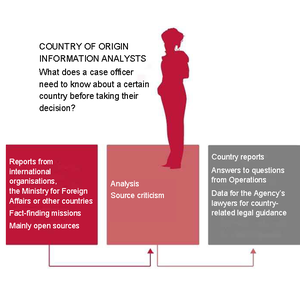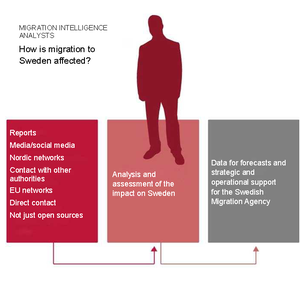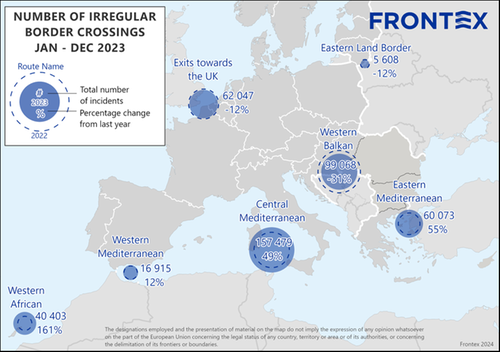The Swedish Migration Agency answers: How is the Swedish Migration Agency monitoring the world around us?
The way the Swedish Migration Agency operates is largely determined by events beyond Sweden’s borders. The Swedish Migration Agency needs information to be able to assess future developments in migration and for taking decisions that are legally secure.
How many people will apply for a work permit – or protection – in Sweden next year? How dangerous is the situation in Afghanistan following the Taliban’s takeover? And what will happen in Ukraine? The Swedish Migration Agency must be able to provide thorough answers to these kinds of questions.
This is why the Agency has a unit that assesses various aspects of migration with the help of two analyst groups – country of origin information analysts and migration intelligence analysts.
Country of origin information analysts – crucial for asylum examinations
The country of origin information analysts study a wide range of information from sources such as organisations, authorities and legislation. They use this information to describe the conditions in a particular country. The information needs of the Swedish Migration Agency’s determine which countries or regions form the basis of a country report, which is then published in the external database, Lifos External link, opens in new window..
External link, opens in new window..
 Zoom image
Zoom imagePress to enlarge.
The country reports are used by those processing and taking decisions in individual cases. They also form an important component of the assessment basis when lawyers at the Swedish Migration Agency establish legal opinions, part of the country-based legal guidance necessary to process cases efficiently, uniformly and in a legally secure manner.
However, the Agency takes individual decisions on asylum cases. These decisions are based on the circumstances of a specific case that determine whether a person will receive protection in Sweden or not.
A country report may be about Somalia and address the current situation in the country in terms of safety, human rights and humanitarian conditions. What have other countries and organisations established about the situation? Are there any people, such as women, LGBTQI people, ethnic groups
or religious communities who are particularly vulnerable? Which regions are more or less safe? These are some of the questions that a country report can answer when a person from Somalia is seeking protection in Sweden.
Migration intelligence analysts create strategic and operational data
The migration intelligence analysts have a different perspective. They are tasked with creating a basis to assess short and long-term developments in migration to Sweden. They analyse developments in the world around us and provide data to the Agency in the form of situational analyses, reports and assessments. This data is used in the Swedish Migration Agency’s prognoses (in Swedish), as well as the strategic and operational work that keeps the Agency running efficiently.
 Zoom image
Zoom imagePress to enlagre.
The migration intelligence analysts investigate what forces people from different countries of origin. They often collaborate with country of origin information analysts. Migration intelligence analysts also examine the accessibility of migration routes, Sweden’s attractiveness as a destination country and the situation in other major European destination countries. Political decisions on migration – both in Sweden and abroad – can have
a major impact on the number of people seeking protection in the country. Sweden’s proportion of the total number of asylum seekers in Europe has decreased over time, and the migration intelligence analysts have a particular focus on the political dimension at both national and EU level.
Together with other experts at the Agency, they analyse the situation in other non-asylum categories to determine how these will develop over time. Work permits are one example of where developments are analysed based on legislation, economic situation and external factors.
The European Border and Coast Guard Agency, Frontex
 Zoom image
Zoom imagePress to enlarge. The map is an example of a typical Frontex document. It illustrates how irregular migration to the EU changed between 2022 and 2023. The term ‘irregular migration’ is used to describe people from a non-EU country who cross borders without meeting the legal requirements to enter the Union. The image shows the primary routes – the routes taken from irregular migrants to enter the EU from non-EU countries. It shows, for example, that migration via the Eastern Mediterranean increased by 55 per cent in 2023 compared to 2022, and that 60 073 people crossed the border into the EU.
Routes illustrated from left to right:
Western Africa
Western Mediterranean
Exits towards the UK
Central Mediterranean
Western Balkan
Eastern Land Border
Eastern Mediterranean
Read more on the Frontex website External link, opens in new window.
External link, opens in new window.
The Ukraine example
Despite months of escalation, few believed there would be a full-scale invasion of Ukraine. When Russia eventually attacked on 24 February 2022, events progressed rapidly. One week later, the EU activated the Temporary Protection Directive and within two weeks, analysts at the Swedish Migration Agency had created an initial scenario of the number of people from Ukraine requiring protection in Sweden*.
The information was comprehensive, but so were the uncertainties. Social media, news media, information from EU networks, Nordic contacts, contact with Swedish authorities, reports from the United Nations High Commissioner for Refugees and EU’s crisis preparedness platform and direct contacts with migration authorities throughout Europe. Despite the number of refugees having decreased significantly since then, Ukraine continues to be the largest country of origin for asylum seekers in Sweden. The most recent forecast suggests that approximately 10 000 Ukrainians will seek protection in Sweden during 2024.
*The initial scenario estimated that approximately 40 000 Ukrainians would seek asylum in Sweden during the period leading up to the regular forecast on 27 April. When the 27 April forecast was finally issued, 34 000 Ukrainians had sought protection in Sweden.
The Gaza example
Following the Hamas attacks of 7 October 2023, Israel launched the ongoing war on Gaza. Just a few days later, the Swedish Migration Agency stopped enforcement to the Gaza Strip, pausing deportations to the area. This may happen when the conditions in an area suddenly become extremely violent and it is difficult to determine how the conflict will develop. In this case, the country of origin information analysts can provide data to the Agency’s Legal Affairs Department for resolving matters relating to deportation and asylum grounds. In contrast, the job of the migration intelligence analyst is to assess whether the current events will affect the refugee situation in the area in the short and long term, and how migration to Sweden will develop in the long run.